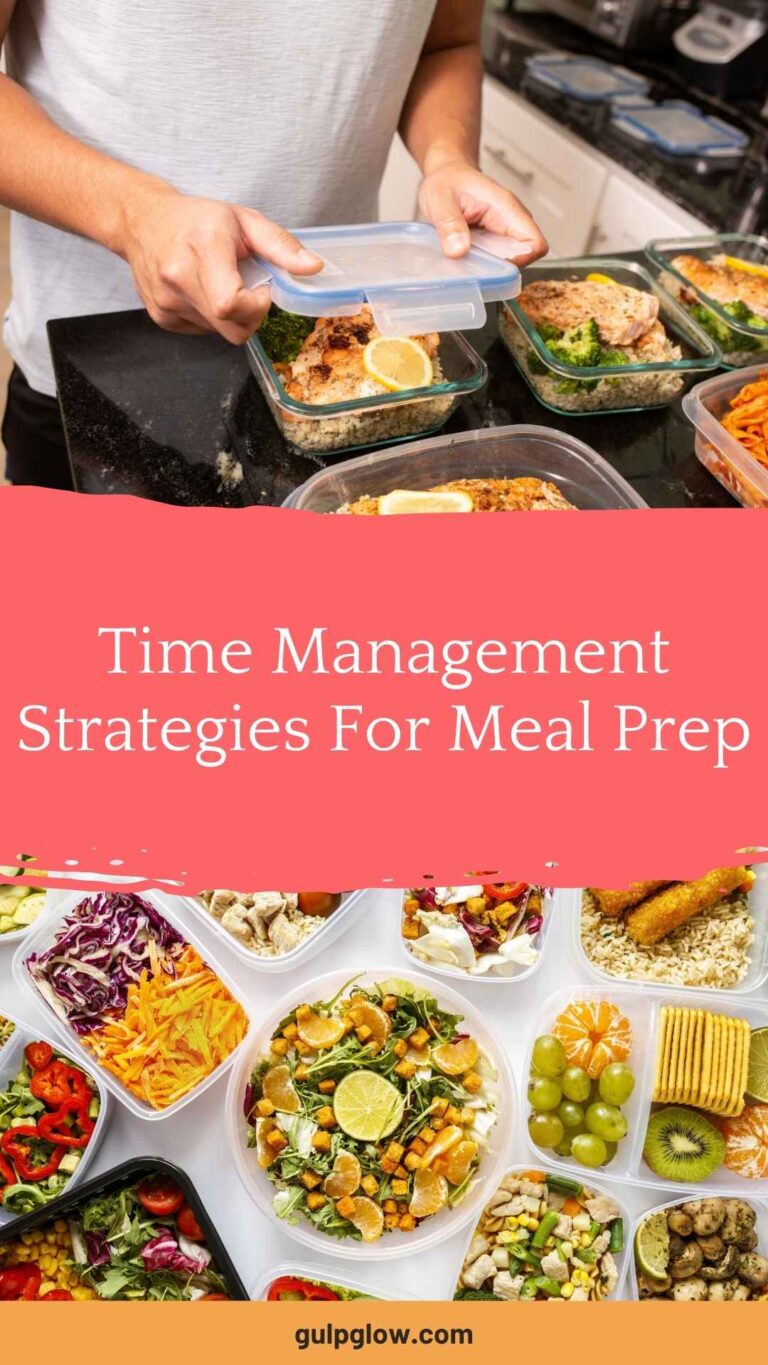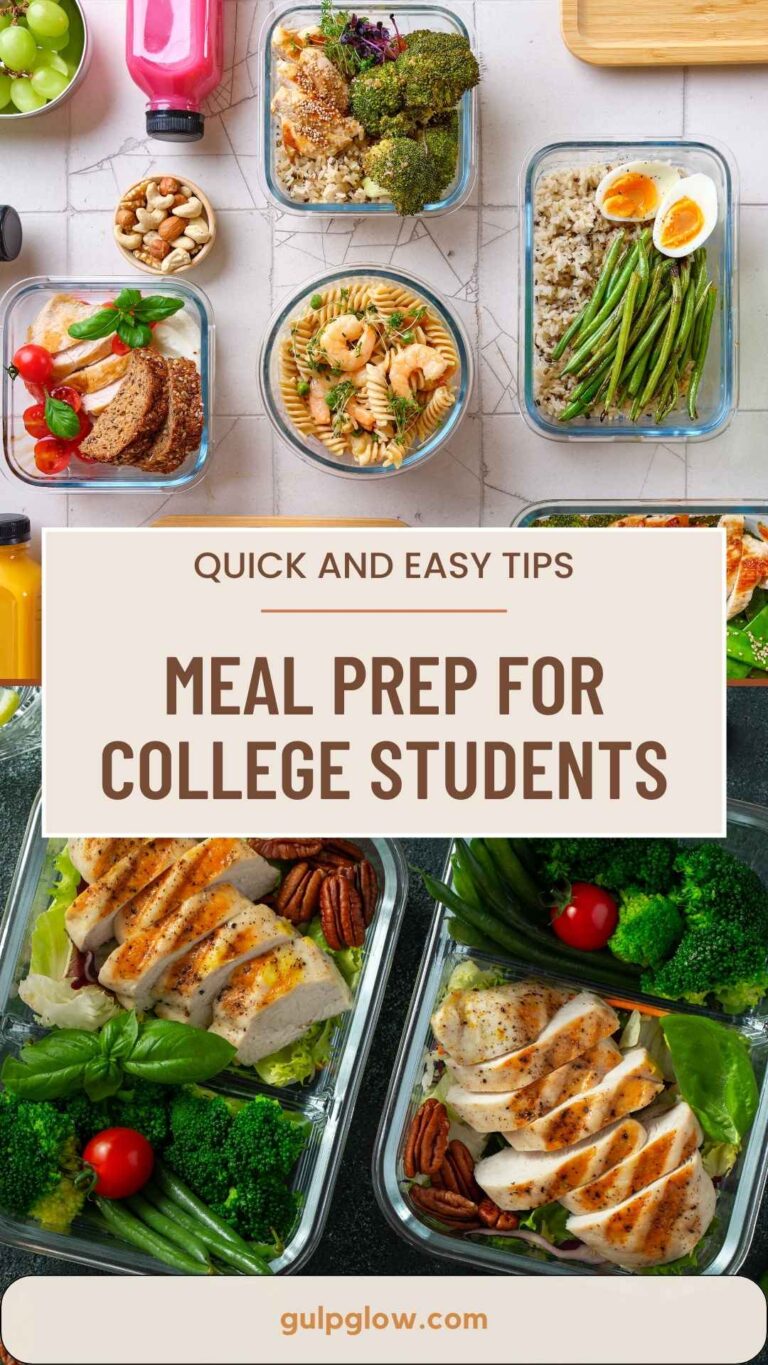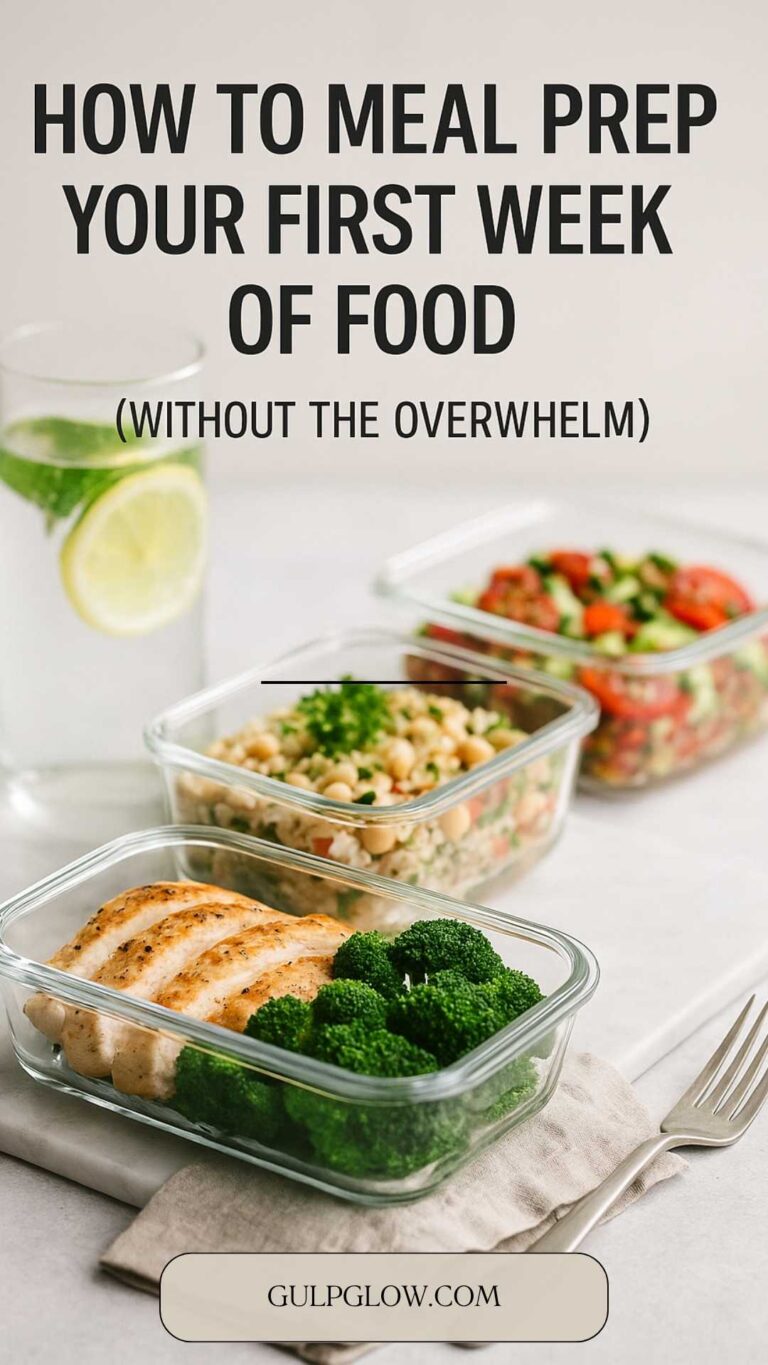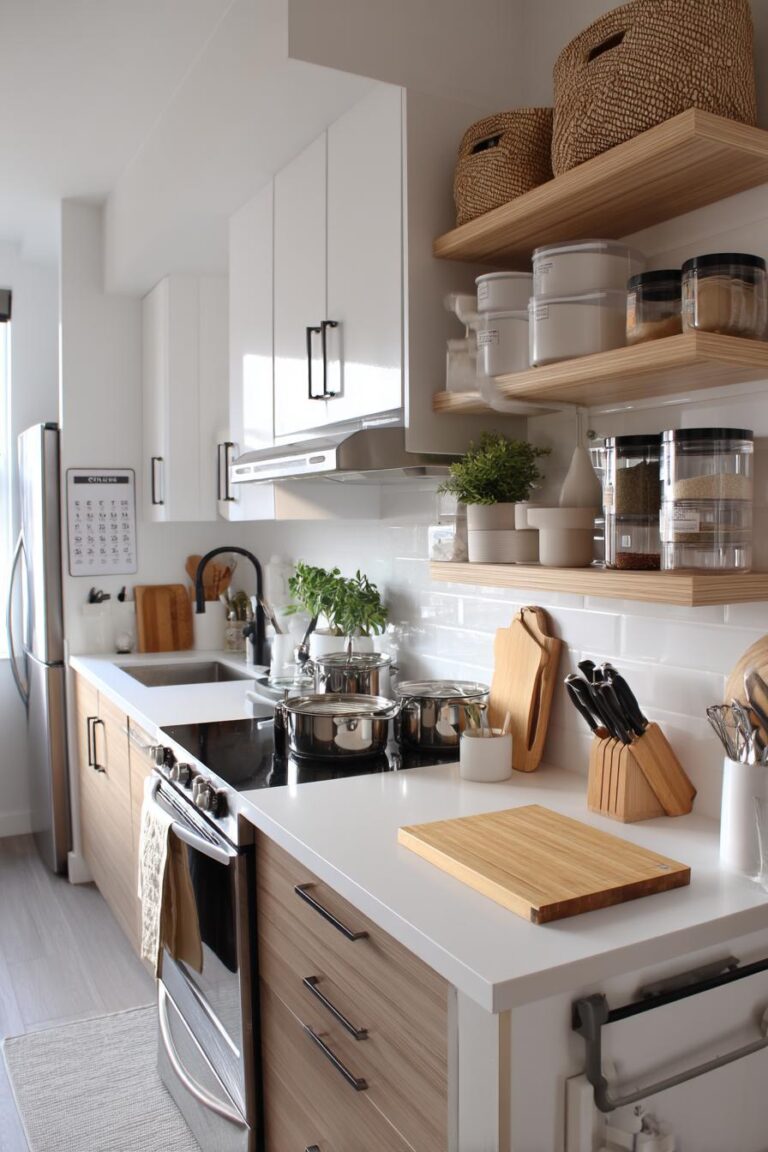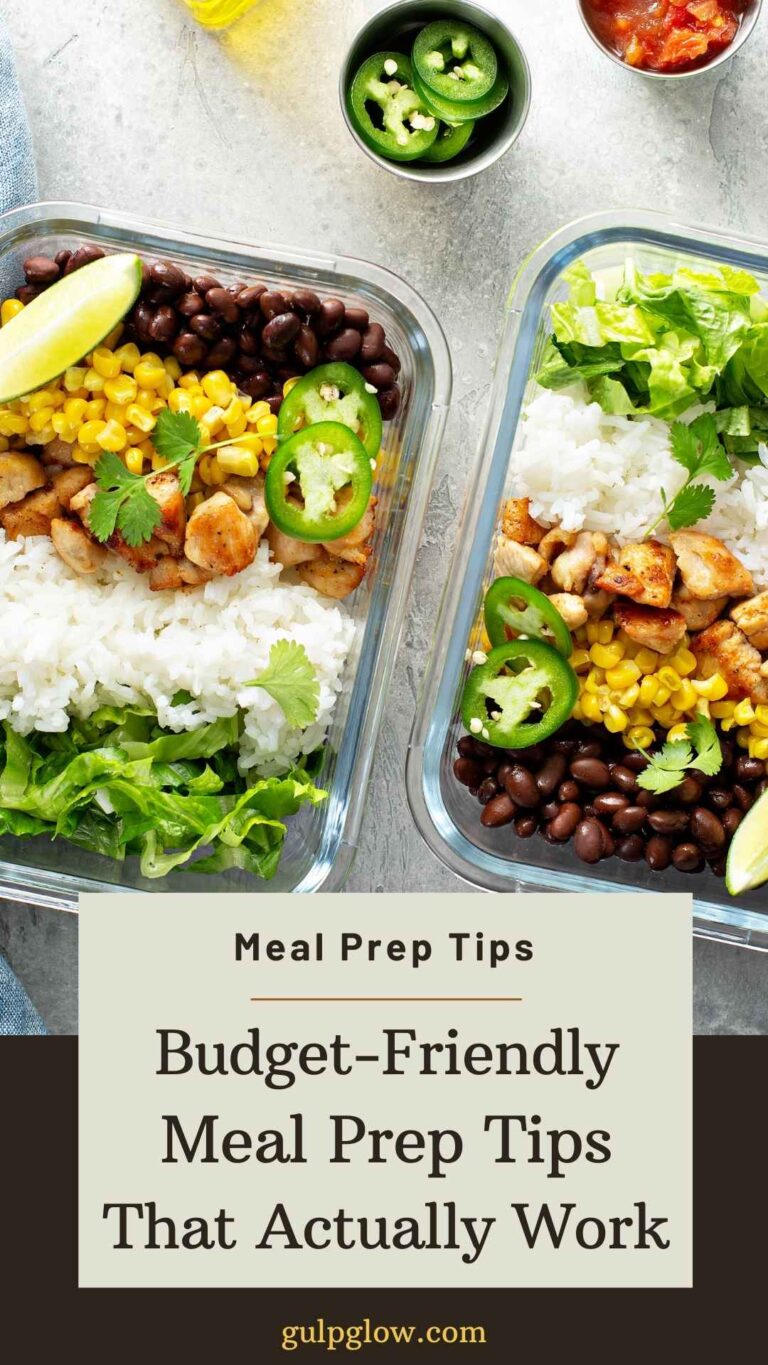Meal Prep for Beginners: Tips and Tricks to Simplify Your Cooking Routine
Tired of the daily “what’s for dinner?” stress? Meal prepping is your answer! It’s simply the act of preparing some or all of your meals ahead of time. By spending a few hours in the kitchen once a week, you can save time, money, and make healthier food choices.
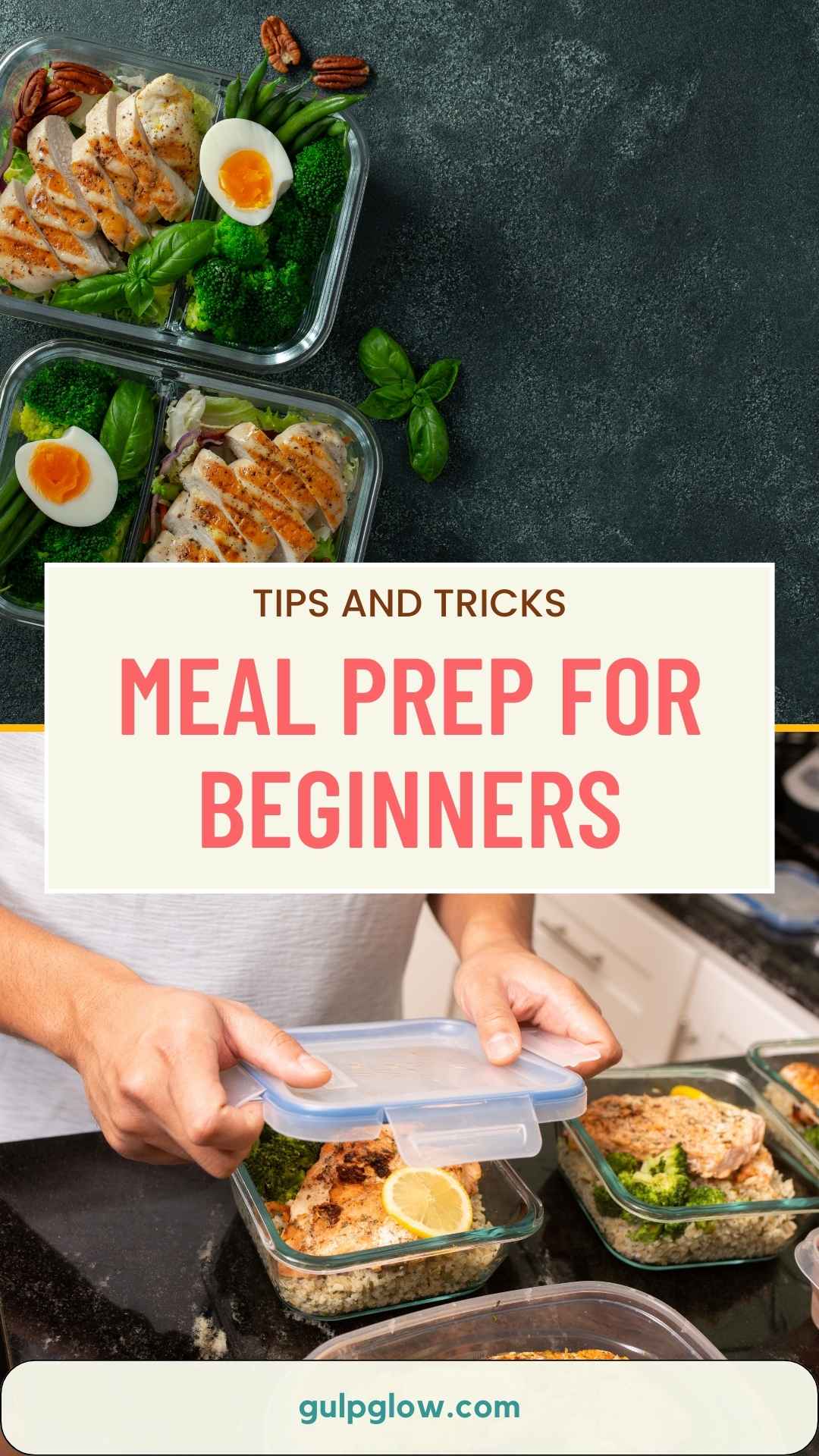
Starting with simple, single-recipe meal preps is the best way for beginners to build a sustainable habit without feeling overwhelmed. You don’t need to prep every meal for the entire week right away. Try preparing just your lunches or focus on cooking protein that can be used in different meals throughout the week.
When you’re ready to begin, focus first on foods that take longest to cook, like proteins and whole grains. Keep things interesting by prepping plenty of vegetables that can be remixed into different meals. Many experienced meal preppers use compartment containers to organize their food into balanced portions that stay fresh for days.
The Essentials of Meal Prepping
Meal prepping is all about setting yourself up for success by planning and preparing your meals ahead of time. This simple practice can transform your eating habits and save you time and money throughout the week.
Understanding Meal Prep
Meal prepping is simply preparing your meals or ingredients in advance. You can prep entire meals ready to eat, or just get ingredients washed, chopped, and stored for quicker cooking later.
There are several approaches to meal prep:
- Full prep: Cook complete meals and portion them out for the week
- Batch cooking: Make large batches of specific recipes to use throughout the week
- Ingredient prep: Wash, chop, and store ingredients to make cooking faster
- Assembled meals: Prepare ingredients that can be quickly combined for fresh meals
You can choose to prep just one meal type (like lunches for work) or plan your entire week. Start small if you’re new to meal prepping – maybe just prep breakfasts or lunches for a few days until you find your rhythm.
Benefits of Meal Prepping
Meal prepping offers many advantages that make the upfront time investment worthwhile. First, it helps reduce food waste since you buy and use ingredients with a plan in mind.
It’s also a money-saver. When you plan meals, you’re less likely to order takeout or make impulse purchases at the grocery store. Many people find they save hundreds of dollars each month!
Health benefits are significant too. When you prep your own meals, you control the ingredients and portions. This makes it easier to eat nutritious foods and avoid processed options when you’re busy or tired.
Time savings is perhaps the biggest benefit. Though you’ll spend a few hours prepping, you’ll save much more time during busy weekdays when meals are ready to heat and eat.
Tools and Equipment Needed
You don’t need fancy equipment to start meal prepping, but a few basics will make the process smoother and more effective.
Storage containers are essential:
- Glass containers with lids (microwave-safe)
- Portion-controlled containers
- Mason jars for salads or overnight oats
- Silicone bags for snacks or freezer storage
Kitchen tools that help streamline the process:
- Sharp knives for efficient chopping
- Cutting boards (separate ones for meat and produce)
- Measuring cups and spoons
- Sheet pans for roasting vegetables or proteins
A slow cooker or Instant Pot can be game-changers for meal prep, allowing you to cook large batches with minimal effort. A good blender is helpful for smoothies, sauces, and soups.
Don’t forget about your freezer space! Having room to store frozen portions is key to successful long-term meal prepping strategies.
Getting Started with Meal Prep
Meal prep doesn’t have to be complicated! With some planning and the right approach, you can set yourself up for a week of easy, healthy eating.
Designing Your Meal Prep Plan
Start by deciding how many meals you need to prepare. Do you want to prep all meals or just lunches for work? Pick 2-3 recipes to begin with rather than trying to prep everything at once.
Think about your schedule for the upcoming week. When will you have time to cook? Many people find Sunday works well for weekly prep.
Choose recipes that use similar ingredients to reduce waste. For example, if you’re roasting chicken for one meal, make extra to use in salads or wraps later in the week.
Consider your food preferences and dietary needs. If you get bored easily, plan for variety. If you’re trying to eat healthier, focus on balanced meals with protein, vegetables, and whole grains.
Creating a Grocery List
Once you’ve decided on your recipes, write down all ingredients needed. Check your kitchen first to avoid buying duplicates.
Organize your list by store sections (produce, meats, dairy, etc.) to make shopping more efficient. This saves time and helps prevent forgotten items.
Include quantities needed for each ingredient. If multiple recipes call for chicken, calculate the total amount required.
Add staples like spices, oils, and pantry basics that might need replenishing. These items form the foundation of your meal prep arsenal.
Consider your budget when planning. Seasonal produce is often cheaper and fresher. Buying in bulk can save money on items you use frequently.
Shopping for Ingredients
Try to shop after you’ve eaten to avoid impulse purchases. Stick to your list, but be flexible if you spot good deals on items you regularly use.
Look for fresh produce that will last through the week. Some vegetables like carrots, cabbage, and bell peppers stay crisp longer than leafy greens.
Buy versatile ingredients that work in multiple recipes. Items like quinoa, chicken, and mixed vegetables can be prepared in different ways throughout the week.
Don’t forget storage containers! Make sure you have enough containers for portioning and storing your prepped meals. Clear containers help you see what’s inside at a glance.
Consider shopping at different stores for the best prices. Farmers markets are great for fresh produce, while bulk stores offer deals on pantry staples.
Practical Meal Prep Strategies
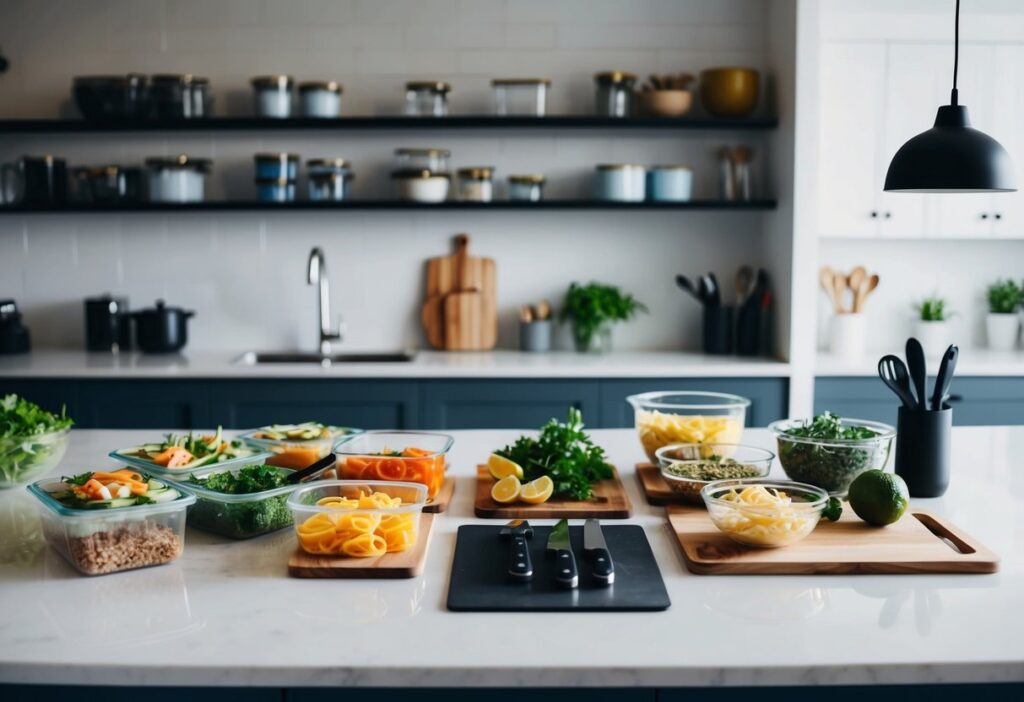
Getting started with meal prep doesn’t have to be complicated. The right strategies can help you save time and money while making healthy eating much easier throughout your busy week.
Batch Cooking Techniques
Batch cooking is your secret weapon for efficient meal prep! Instead of cooking daily, dedicate 1-2 hours once or twice a week to prepare multiple meals.
Try the “cook once, eat twice” method by doubling recipes. When you make chili, stew, or casseroles, make extra portions to freeze for later. This approach can cut your weekly cooking time in half!
Keep the grill or oven running longer to cook extra protein while you’re at it. Roast a whole chicken plus extra chicken breasts, or grill several pounds of meat at once.
Mix up your cooking methods to prevent boredom. Use your slow cooker for stews, oven for roasting vegetables, and stovetop for quick stir-fries – all happening simultaneously to maximize your efficiency.
Prepping Ingredients in Advance
Having prepped ingredients ready makes weeknight cooking much faster. Wash and chop vegetables as soon as you get home from grocery shopping.
Store cut veggies in clear containers in your fridge for easy grabbing. Bell peppers, onions, carrots, and broccoli can stay fresh for 3-5 days when properly stored.
Pre-cook grains like rice, quinoa, and pasta in big batches. They reheat beautifully and save tons of time during the week. One cup of dry rice yields about three cups cooked—enough for several meals!
Make versatile bases that can transform into different dishes. Cook plain chicken, rice, and veggies that can become stir-fry one day and tacos the next.
Storing Your Meals
Invest in good quality food storage containers that are microwave-safe, stackable, and preferably glass. This makes reheating easier and helps you see what’s inside.
Label everything with dates! Use masking tape and a marker to note when you prepared the meal. Most prepped meals stay fresh in the refrigerator for 3-5 days.
For longer storage, the freezer is your friend. Many prepped meals freeze well for 1-3 months. Cool food completely before freezing to prevent ice crystals from forming.
Store similar items together in your fridge or freezer. Having a designated “meal prep zone” makes it easier to grab what you need. Try arranging containers by meal type or by the day you plan to eat them.
Healthy Eating with Meal Prep
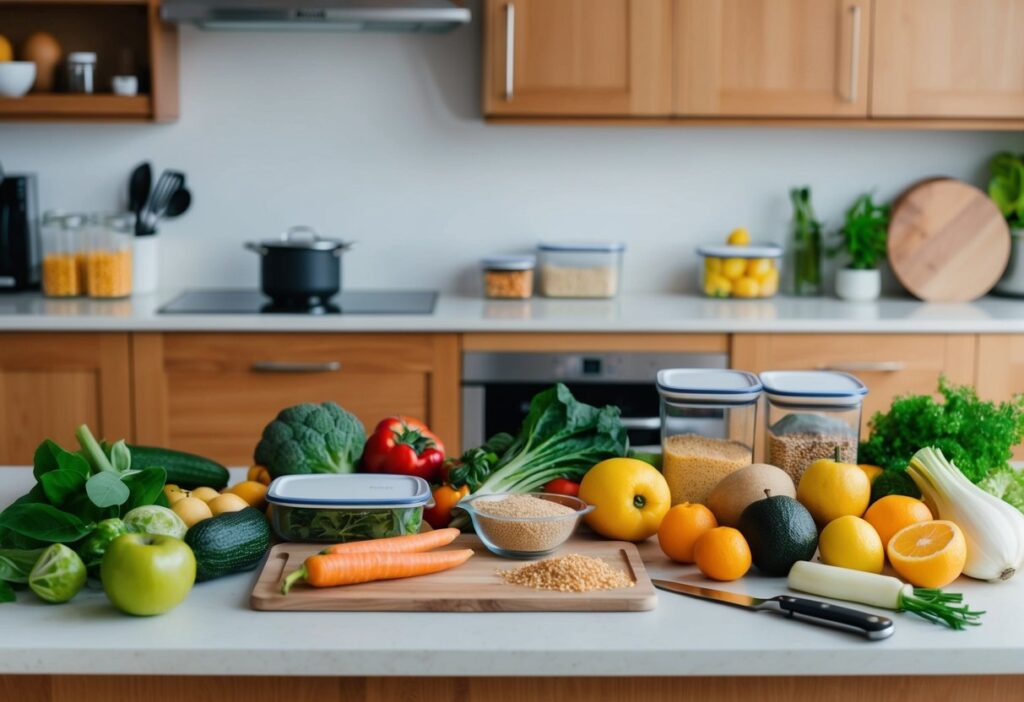
Meal prep is a powerful tool for healthy eating. It helps you control ingredients, portion sizes, and make nutritious choices even on your busiest days.
Balancing Nutrients in Your Meals
A well-balanced meal prep should include proteins, carbs, and healthy fats. Aim to fill about half your container with colorful veggies, a quarter with lean proteins, and a quarter with complex carbs.
Protein options to consider:
- Grilled chicken or turkey
- Beans and lentils
- Tofu or tempeh
- Eggs or egg whites
- Fish like salmon or tuna
Whole grains like brown rice, quinoa, and whole wheat pasta make great pantry staples that provide fiber and sustained energy. Don’t forget healthy fats from avocados, nuts, seeds, or olive oil!
Try batch cooking a few proteins and veggies on Sunday. You can mix and match them throughout the week for different meals.
Incorporating Variety
Eating the same healthy meal every day gets boring fast! Keep things interesting by prepping components rather than full meals.
For example, roast several vegetables with different seasonings. Prepare two protein sources. Then combine them in different ways throughout the week.
Try these variety boosters:
- Use different spices and herbs for similar ingredients
- Switch up your cooking methods (roasting, steaming, sautéing)
- Prepare versatile bases like salad greens or cauliflower rice
- Keep a few different dressings or sauces on hand
Frozen fruits and vegetables are great backup options. They’re nutritious, affordable, and last much longer than fresh. Adding a new recipe to your rotation each week keeps meals exciting and expands your cooking skills!
Time-Saving Tips for Busy Lifestyles
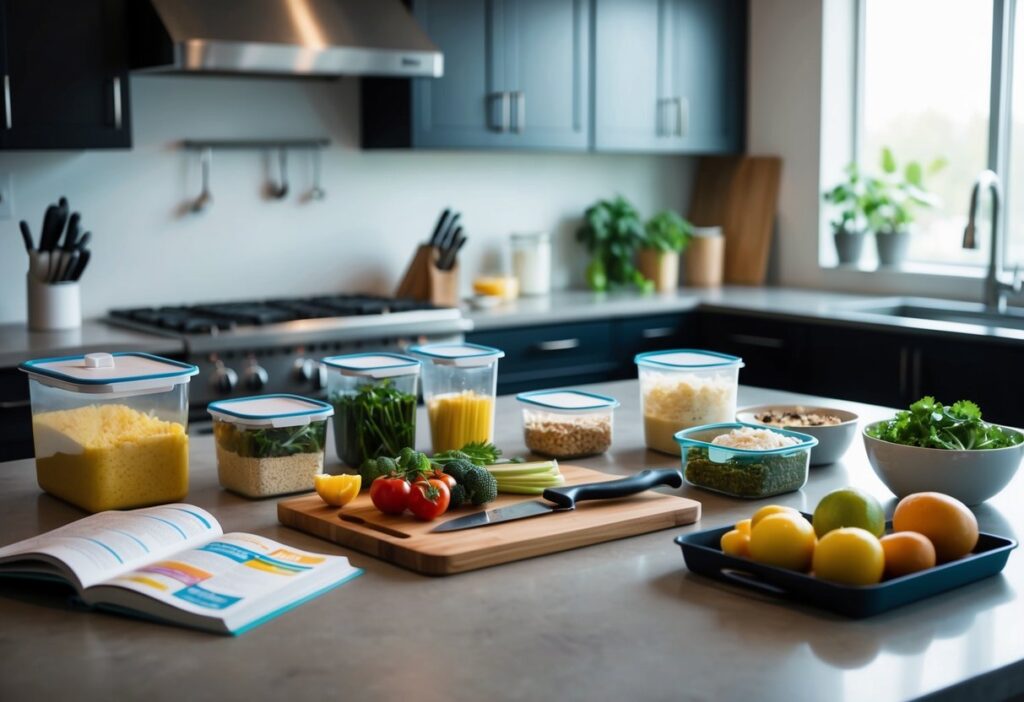
Meal prepping doesn’t have to eat up your entire weekend. With a few smart strategies, you can save time while still enjoying healthy, homemade meals throughout your busy week.
Quick Meal Prep Ideas
Start by focusing on just one meal that causes you the most stress. Many people find prepping breakfast or lunch makes the biggest difference in their daily routine.
Keep your grill going a few extra minutes to cook chicken or vegetables for tomorrow’s meals. This simple step can save you tons of time later.
Try the “cook once, eat twice” method. When making dinner, double the recipe so you automatically have leftovers for lunch the next day.
Prep ingredients rather than full meals when you’re short on time:
- Chop vegetables for the week
- Cook a batch of grains like rice or quinoa
- Pre-portion snacks into grab-and-go containers
Use kitchen tools that speed up the process. A slow cooker, instant pot, or food processor can dramatically cut down your active cooking time.
Managing Meal Prep Time
Set aside a specific 4-hour block for meal prepping. This focused time investment will improve your entire week by eliminating daily cooking stress.
You don’t need to tackle the whole week at once! Start with just 2-3 days of meals until you develop a system that works for you.
Batch similar tasks together to work more efficiently. Chop all vegetables at once, then cook all proteins, rather than completing one recipe at a time.
Make a “prep playlist” with your favorite music or podcast to make the time more enjoyable. When meal prep becomes fun, you’re more likely to stick with it.
Create a simple meal prep calendar to track what you’re making and when you’ll eat it. This prevents food waste and helps you stay organized.
Budget-Friendly Meal Prep Ideas
Meal prepping doesn’t have to drain your wallet! With smart planning and a few simple strategies, you can create delicious, healthy meals that save you both time and money throughout the week.
Affordable Meal Prep Recipes
Taco bowls are a fantastic budget option at around $12-13 total for multiple servings. Combine $4 worth of ground beef, $1 of rice, frozen corn, bell peppers, red onion, tomatoes, canned black beans, and cilantro for a complete meal.
Try making a full budget meal prep with just 11 ingredients that turn into 7 meals for less than $3 each! Focus on versatile ingredients that can work in multiple dishes.
Single-recipe meal preps are perfect for beginners. Start with big-batch recipes like:
- Chili or stews (freeze portions)
- Bean and rice bowls with different toppings
- Pasta bakes with seasonal vegetables
- Oatmeal prepped in batches with various mix-ins
Remember that plant-based options like beans and lentils are often cheaper than meat while still providing protein.
Shopping on a Budget
Plan your shopping trips around weekly sales and seasonal produce. Check flyers before making your list to see what proteins and vegetables are discounted.
Buy in bulk for items you use regularly. Rice, beans, oats, and frozen vegetables offer great value and long shelf life.
Smart shopping tips:
- Compare unit prices, not just total cost
- Choose store brands over name brands
- Shop at discount grocery stores when possible
- Buy whole foods rather than pre-cut or processed options
- Consider frozen fruits and vegetables (often cheaper and last longer)
Don’t shop hungry! This simple rule can save you from impulse purchases that break your budget.
Reducing Food Waste
Use everything you buy to maximize your grocery dollars. Plan meals that use the same ingredients in different ways throughout the week.
Store foods properly to extend freshness. Wrap greens in paper towels, keep herbs in water like flowers, and freeze bread you won’t use immediately.
Create a “use first” bin in your fridge for items that need to be eaten soon. This visual reminder helps prevent forgotten food from spoiling.
Turn vegetable scraps into stock, stale bread into croutons, and wilting produce into soups or smoothies. Almost nothing needs to go to waste!
Track what you typically throw away and adjust your shopping accordingly. If you consistently toss certain items, buy less or find new recipes to use them up.
Maintaining Meal Prep Momentum
Keeping up with meal prep takes some effort, but the rewards are worth it. The key is finding ways to stay motivated, work through challenges, and celebrate your successes along the way.
Staying Motivated
Mix things up regularly to avoid meal fatigue. Try a new recipe each week alongside your favorites to keep things interesting.
Create a meal prep playlist or podcast lineup that makes kitchen time feel fun rather than like a chore. You might be surprised how much more enjoyable chopping vegetables becomes with your favorite tunes playing!
Find a meal prep buddy who shares similar goals. Check in with each other weekly, share recipes, or even host virtual cook-along sessions. Having someone to share the journey makes it more enjoyable.
Set clear goals for your meal prep routine. Whether you want to save money, eat healthier, or save time during busy weekdays, keeping your “why” in mind helps maintain motivation when the process feels tedious.
Addressing Challenges and Adjustments
Start small if you’re feeling overwhelmed. Prep just breakfast or lunch for the week instead of every meal. You can gradually build up as you become more comfortable.
Keep a running list of what works and what doesn’t. Maybe those glass containers are too heavy for your commute, or perhaps you discovered salads stay fresher when you pack the dressing separately.
Be flexible with your approach. Some weeks might be busier than others. During hectic times, focus on semi-prep—washing and chopping vegetables or marinating proteins—rather than cooking complete meals.
Have backup options ready for when meal prep doesn’t happen. Stock your pantry and freezer with healthy emergency meals that require minimal effort.
Celebrating Your Meal Prep Successes
Take before-and-after photos of your fridge or meal containers. Seeing a week’s worth of prepared meals lined up is surprisingly satisfying!
Track your savings. Note how much money you’re saving by not ordering takeout or buying lunch. Consider putting those savings toward something special as a reward.
Notice improvements in your daily life. Are you feeling more energetic? Spending less time stressing about what to eat? Enjoying more free time in the evenings? Acknowledge these positive changes.
Share your wins with others. Post your meal prep achievements on social media or tell friends about that amazing batch of overnight oats you made. Receiving positive feedback boosts your motivation to continue.


